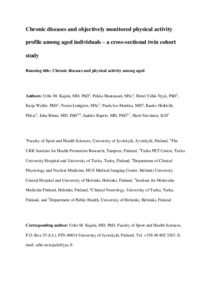Chronic diseases and objectively monitored physical activity profile among aged individuals – a cross-sectional twin cohort study
Kauko Heikkilä; Harri Sievänen; Pekka Hautasaari; Henri Vähä-Ypyä; Paula Iso-Markku; Juha Rinne; Katja Waller; Urho M. Kujala; Noora Lindgren; Jaakko Kapri
https://urn.fi/URN:NBN:fi-fe2021042822821
Tiivistelmä
Introduction: High physical activity (PA) at old age indicates good functional capacity enabling independent living. We investigated how different disease conditions are associated with measured PA indicators in old women and men, and whether they recognize this association.
Materials and methods: This cross-sectional twin cohort study in Finland comprised 779 individuals (276 complete twin pairs, including 117 monozygotic pairs), who participated in hip-worn accelerometer monitoring of PA and responded to questions on diseases and mobility limitations at mean age of 73 (range 71–75).
Results: Of the participants, 23.2% reported having a disease restricting mobility. With sex and age in the regression model, the reported disease restricting mobility explained 11.8% of the variation in moderate-to-vigorous PA (MVPA) and 10.4% of the variation in daily steps. Adding stepwise other self-reported diseases and body mass index to the model increased the explanatory power for MVPA up to 18.5% and 25.5%, and for daily steps up to 16.0% and 20.7%, respectively. In the co-twin control analysis the PA differences were smaller in disease-discordant monozygotic than dizygotic pairs.
Conclusions: Chronic disease conditions are associated with low PA, which individuals may not always recognize. Shared genetic factors may explain part of the associations.
Kokoelmat
- Rinnakkaistallenteet [19207]
